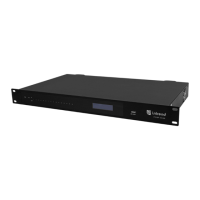Operating Manual for Digital Sound Processor (DSP) V3.0
WWW.INTREND-AV.RU
38
Suppression level: There are totall
levels including Mild(6dB),Medium(10dB)
and A
ggressive(15dB) for selection. dB
here refers to the decibel of suppression
noise reduction. The bigger the value, the
more harm on voice generated, which is
inevitable.
3.4.14 Matrix
Matrix has dual operation functions including router and sound mixing. As shown in the figure, the
horizontal direction indicates the input channel and the vertical direction indicates output channel.
One-to-one input and output is the default setting. If it’s necessary to mix voices of channel 1 and
channel 2 and then output to channel 1, users only need to click 1s on both horizontal and vertical
directions at output channel 1. If input 1 and 2 participate in automixing, then the output will not be
influenced by it. Similarly, after setting automixing, echo cancellation and noise suppression module,
users also need to set matrix to get correct signal route relation.
3.4.15 High & Low Pass Filter
Each output channel provides high- and low-pass modules which consist of high- and low-pass filters.
Each filter has four kinds of parameters as follows:
Frequency: The cutoff frequency of filters. The cutoff frequency of Bessel and Butterworth is defined
at -3 dB, and the cutoff frequency of Linkwitz-riley is defined at -6dB.
Gain: Gain setting influences the promotion and attenuation of full band.
Type: There are three types of filters including Bessel, Butterworth and Linkwitz-riley. Butterworth has
the flattest passband.
Slope: It refers to attenuation values of transition zone of filters. There are totally 8 attenuation values
including 6, 12, 18, 24, 30, 36, 42 and 48dB/Oct. For example, 24dB/Oct indicates that the attenuation
range is 24dB for each octave difference existed in frequency in transition zone.
Users may click bottom activate button to activate high- or low-pass module.

